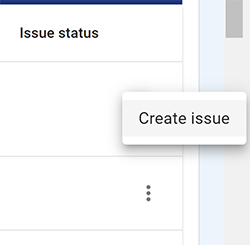Tolerances
What is different?
Previously, you could request a switch for errors by contacting Liaison.
From the Student 2022/23 collection, this is all handled by the HDP and you will no longer contact Liaison for a switch.
Please raise all quality issues in the IMS and request a tolerance override within the issue. These issues will either be self-approved by the provider, or approved by HESA or the relevant Statutory Customer.
This means that rules that were previously warnings will also be dealt with in the same way, and a tolerance override will need to be requested.
How to raise a tolerance override request
Please raise tolerance override requests for issues that are triggering for a genuine reason. More details are available in the IMS user guide.
1 - In the HDP ‘Create issue’ for the relevant rule by selecting the three dots under 'Issue status' then 'Create issue'. This will automatically create an issue in the IMS. Only request a tolerance override when the issue is triggering for the total number of records expected. Otherwise, you will need to request the tolerance again when it triggers for more records. Tolerances should not be requested for quality rules that are known issues. The known issues log can be found by clicking on the support guides for the relevant collection on the Data Collection page. If the rule is on the known issues page, please disregard the rule for the time being. We will update the page once it is resolved. If a quality rule is not listed as a known issue please contact [email protected].

2 - Within the issue select the ‘Request Override’ button.
3 - Make sure you enter a value for the number of records the rule is triggering for. This will be the tolerance that you want to apply to this rule: if it is triggering for 33.33% of records, the tolerance override value will be 33.33%. The tolerance override box must be filled in before the request can be reviewed.
In some cases it may be appropriate to request a tolerance as a higher count or percentage than is currently triggering the rule. This may be in the case where it is expected that the records triggering a rule will increase. If you are requesting a tolerance at a higher level that is currently triggering, please include information in your request as to why this is. This will then be considered by your Statutory Customer or HESA when approving the tolerance. This may not be approved in all cases, for example high priority rules where any increase in numbers would need to be confirmed.
4 - Provide a supporting explanation for why this data is genuine.
5 - The tolerance request will go to the relevant approver for that rule, e.g. HESA or a Statutory Customer.
6 - If the tolerance override is approved the query will be archived and the provider will receive a notification. If it is a provider-approved rule, the query will be archived.
7 - Once a tolerance override is approved, please resubmit the file for the rule to move inside tolerance, or Liaison can re-process your most recent file upon request.
8 - If the tolerance is declined, then a comment will be added to explain why and the issue will be assigned back to the provider.
The Issue Management System can be accessed here: https://issuemanagement.hesa.ac.uk/
All quality issues will need to be resolved, either by an amendment in tolerance or correction to the data to progress to the final ‘Approval & sign-off’ stage.
Rolling tolerances
When your Statutory Customer or HESA is reviewing a tolerance request, this can be applied to multiple reference periods if applicable. When applying for a tolerance, please indicate if the tolerance should apply to multiple reference periods. This is done on the basis of a count of reference periods. So a tolerance applied in 23056 with a rolling tolerance of 1 would apply to the 23056 and 24056 reference periods.
IMS best practice tips
1 - Check the known issues page if a rule isn’t working as expected before requesting a tolerance override. The known issues log can be found by clicking on the support guides for the relevant collection on the Data Collection page. If the rule is on the known issues page, please disregard the rule for the time being. We will update the page once it is resolved. If a quality rule is not listed as a known issue please contact [email protected].
2 - You don’t need to request a decommit. If you have changes then you can upload a new file to the HDP. This will update any open IMS queries that you have.
3 - Complete the Data Futures Quality Assurance e-learning to supplement your understanding.
4 - If you plan to upload a new file to fix an issue, you don’t need to add a comment. However, you could mark it as ‘awaiting resubmission’.
